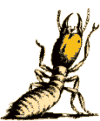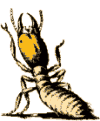 an initial thorough inspection of the buildings and surrounds, an initial thorough inspection of the buildings and surrounds,
 the installation of a chemical soil barrier at the base of the building, the installation of a chemical soil barrier at the base of the building,
 drilling of trees and stumps to eradicate any white ant nest found therein, drilling of trees and stumps to eradicate any white ant nest found therein,
 the installation and monitoring of a white ant colony elimination system, the installation and monitoring of a white ant colony elimination system,
 application of borate chemical to accessible structural timbers, application of borate chemical to accessible structural timbers,
 various non-chemical building site modifications, various non-chemical building site modifications,
 regular follow-up inspections and maintenance of the control methods, regular follow-up inspections and maintenance of the control methods,
 installation of physical barriers and other devices during construction. installation of physical barriers and other devices during construction.
| Initial Inspection of Buildings & Surrounds |

 Firstly, it is essential for the white ant controller to complete a thorough inspection of the buildings and surrounds, in accordance with the Australian Standard 3660. Firstly, it is essential for the white ant controller to complete a thorough inspection of the buildings and surrounds, in accordance with the Australian Standard 3660.
 AS 3660 requires the property owner to be supplied with a written inspection report and detailed specifications for an integrated white ant control program. It is a legal requirement that (1) such an inspection and report be carried out prior to a chemical soil treatment, and (2) only a Govt WorkCover licensed pest controller may supply the chemical soil treatment. AS 3660 requires the property owner to be supplied with a written inspection report and detailed specifications for an integrated white ant control program. It is a legal requirement that (1) such an inspection and report be carried out prior to a chemical soil treatment, and (2) only a Govt WorkCover licensed pest controller may supply the chemical soil treatment.
 The cost of a white ant inspection report and quotation / treatment recommendations is usually around $150 to $250, depending on the size of the premises. Some companies offer a "free inspection" but inevitably meet the cost from subsequent services to property owners who accept the quotation / treatment proposal. The cost of a white ant inspection report and quotation / treatment recommendations is usually around $150 to $250, depending on the size of the premises. Some companies offer a "free inspection" but inevitably meet the cost from subsequent services to property owners who accept the quotation / treatment proposal.
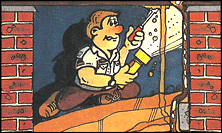 |
A professional white ant inspection and report could save you thousands of dollars - specific areas inspected include accessible timbers within the sub-floor, roof void, exterior and interior of the building and other timber structures, fences and trees within a 50 metre radius of the buildings but within the property boundary. |
 CONSUMER NOTE: If you find active 'live" white ants on your property, you should contact the owners of neighbouring properties to alert them of the white ant risk in the area and the need to arrange for an inspection and a white ant control program at their premises. White ants can travel in about a 100 metre radius from their central colony nest. A white ant control program in neighbouring properties will increase the prospects of a successful white ant colony elimination program, for the benefit of all concerned. CONSUMER NOTE: If you find active 'live" white ants on your property, you should contact the owners of neighbouring properties to alert them of the white ant risk in the area and the need to arrange for an inspection and a white ant control program at their premises. White ants can travel in about a 100 metre radius from their central colony nest. A white ant control program in neighbouring properties will increase the prospects of a successful white ant colony elimination program, for the benefit of all concerned.
 An inspection of a building for signs of white ant activity often has physical limitations. white ant entry into the building may be through areas inaccessible to inspection, such as, via expansion joints or cracks in concrete (on-ground flooring), in-fill patios or enclosed wall cavities. White ants often enter a building via external weep holes in wall cavities, particularly where lawns, garden beds, concrete pathways or paving obscure such weep holes. An inspection of a building for signs of white ant activity often has physical limitations. white ant entry into the building may be through areas inaccessible to inspection, such as, via expansion joints or cracks in concrete (on-ground flooring), in-fill patios or enclosed wall cavities. White ants often enter a building via external weep holes in wall cavities, particularly where lawns, garden beds, concrete pathways or paving obscure such weep holes.
 white-ants often build their colony nest inside an in-fill patio - a prime feeding site as builders traditionally dispose of the timber off-cuts inside the patio with soil placed therein and the concrete floor thereon. This also creates a perfect humi-crib breeding site for white ants. From this location the white ants can gain undetected access to the wall and roofing timbers. White ants are extremely secretive - readily trailing under floor tiling, carpets, parquetry to get into the wall and roofing timbers. white-ants often build their colony nest inside an in-fill patio - a prime feeding site as builders traditionally dispose of the timber off-cuts inside the patio with soil placed therein and the concrete floor thereon. This also creates a perfect humi-crib breeding site for white ants. From this location the white ants can gain undetected access to the wall and roofing timbers. White ants are extremely secretive - readily trailing under floor tiling, carpets, parquetry to get into the wall and roofing timbers.
 AS 3660 requires the white ant inspection report to note any visible evidence found of white ant activity, including possible white ant entry points that are inaccessible to inspection and the inspector's recommendations for white ant control treatments. AS 3660 requires the white ant inspection report to note any visible evidence found of white ant activity, including possible white ant entry points that are inaccessible to inspection and the inspector's recommendations for white ant control treatments.
| Chemical Soil Barrier Treatments |

 CONSUMER NOTE: Most home-owners are unaware that their general home insurance policy does NOT cover white ant damage to structural timbers. However, we carry professional indemnity insurance to cover white ant damage to structural timbers in a building caused by white ant gaining entry into a building through treated soil areas. CONSUMER NOTE: Most home-owners are unaware that their general home insurance policy does NOT cover white ant damage to structural timbers. However, we carry professional indemnity insurance to cover white ant damage to structural timbers in a building caused by white ant gaining entry into a building through treated soil areas.
 The chemical soil treatment involves treating the soil at the base of a building with a registered chemical that will prevent white ants travelling through that soil to get to the timbers in the building above. The chemical soil treatment involves treating the soil at the base of a building with a registered chemical that will prevent white ants travelling through that soil to get to the timbers in the building above.
 If there are white ants in the building, at the time of chemical soil treatment, they cannot safely return to their central colony nest via chemically treated soil. White ants are compelled to regularly return to their nest in the ground to obtain moisture essential for their survival and to feed and groom the nymphs (young white ants), the king, queen and other white ants. If there are white ants in the building, at the time of chemical soil treatment, they cannot safely return to their central colony nest via chemically treated soil. White ants are compelled to regularly return to their nest in the ground to obtain moisture essential for their survival and to feed and groom the nymphs (young white ants), the king, queen and other white ants.
 The installation of a chemical soil barrier requires expert knowledge and specialised equipment to form a complete and continuous barrier to protect the building from a white ant entry and infestation - as illustrated below:
The installation of a chemical soil barrier requires expert knowledge and specialised equipment to form a complete and continuous barrier to protect the building from a white ant entry and infestation - as illustrated below:
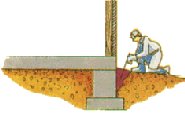
|

|

|
| Trench and treat soil around the external concrete slab edge -
a common white ant entry point. |
Trench and treat soil around walls and piers in the sub-floor area. |
Use rod injection to treat soil along and around the external perimeter area of the building. |
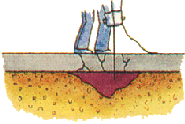
|
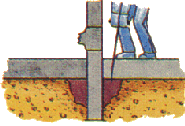
|
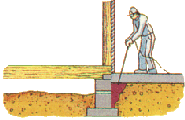
|
| Drill concrete floor along all expansion joints and cracks, and treat soil thereunder. |
Drill concrete floor around pipes and treat soil thereunder.. |
Drill concrete patio areas and along concrete pathways, and treat soil therein. |
 Special care needs to be taken to ensure a subsidiary white ant nest is NOT contained within the building, such as in wall cavities. This may occur where there is an independent moisture source within the wall cavities, for example, from to a leaking shower recess, broken roof tiles or faulty guttering. Special care needs to be taken to ensure a subsidiary white ant nest is NOT contained within the building, such as in wall cavities. This may occur where there is an independent moisture source within the wall cavities, for example, from to a leaking shower recess, broken roof tiles or faulty guttering.
 Recent industry surveys suggest that about one third of all unprotected properties are subject to attack by white ants. Severe white ant damage to Australian homes is on the increase due to recent changes in the type of chemicals allowed to be used and building construction materials and design that encourage hidden white ant entry and infestation. Recent industry surveys suggest that about one third of all unprotected properties are subject to attack by white ants. Severe white ant damage to Australian homes is on the increase due to recent changes in the type of chemicals allowed to be used and building construction materials and design that encourage hidden white ant entry and infestation.
 |
DON'T RISK IT - in most cases the best white ant control protection available will include a complete chemical soil barrier treatment to AS 3660 using Premise soil treatment chemical, together with the installation and regular monitoring of a white ant colony elimination system - discussed in detail later on. |
| PESTICIDE SAFETY ISSUES - Soil Treatment Chemicals |

There are three chemicals registered by the relevant Federal Government - National Registration Authority for use in white ant control as a soil treatment chemical, namely;
 |
chlorpyrifos........trade names of Dursban and Deter,
bifenthrin............trade name of Biflex and,
imidacloprid......trade name Premise
the safest most effective product available |
WARNING: Both Dursban (chlorpyrifos) and Biflex (bifenthrin) are solvent based pesticides which can cause health problems to asthmatics during the drying process. Both Dursban and Biflex are Schedule 6 Pesticides with a "POISON" label rating.
The Safer Effective Alternative is Premise.
 Premise is water based, non-odorous and of very low toxicity to humans, dogs, cats and other mammals. It is classified as a low hazard Schedule 5 chemical with a "CAUTION" notation on the registered label. Premise is water based, non-odorous and of very low toxicity to humans, dogs, cats and other mammals. It is classified as a low hazard Schedule 5 chemical with a "CAUTION" notation on the registered label.
 Premise does NOT have an obnoxious odor or emit airborne residues or fumes, unlike Dursban and Biflex. Premise does NOT have an obnoxious odor or emit airborne residues or fumes, unlike Dursban and Biflex.
 Premise has been used by the white ant control service industry, as soil treatment barrier against white ants for more than five years in Australia (more than seven years in the USA) with effective results for long term effective white ant control. Premise has been used by the white ant control service industry, as soil treatment barrier against white ants for more than five years in Australia (more than seven years in the USA) with effective results for long term effective white ant control.
 Premise represents modern technology (1) it is NOT an organo-chlorine or organo-phosphate pesticide, and (2) white ants cannot detect the chemical. Premise represents modern technology (1) it is NOT an organo-chlorine or organo-phosphate pesticide, and (2) white ants cannot detect the chemical.
 Premise is non-repellant to the white ants. White ants can enter the Premise treated soil zone without detecting the chemical ....it's like a minefield, but once they enter this zone, they are killed by the chemical. The repellant nature of the alternative product means the white ants can readily move along such a chemical barrier seeking a gap to gain entry into the building. Premise is non-repellant to the white ants. White ants can enter the Premise treated soil zone without detecting the chemical ....it's like a minefield, but once they enter this zone, they are killed by the chemical. The repellant nature of the alternative product means the white ants can readily move along such a chemical barrier seeking a gap to gain entry into the building.
 Premise kills the white ants fast and even in soil areas of lower dose rates the research studies show, the white ants will become disorientated, stop feeding, and are fatally diseased by natural fungi and micro-organisms in the soil. Interestingly, some of the affected white ants get back to the central nest to contaminate other white ants in the central nest. We have experienced no significant problems with Premise in the five years of it's extensive use in Australia. Premise kills the white ants fast and even in soil areas of lower dose rates the research studies show, the white ants will become disorientated, stop feeding, and are fatally diseased by natural fungi and micro-organisms in the soil. Interestingly, some of the affected white ants get back to the central nest to contaminate other white ants in the central nest. We have experienced no significant problems with Premise in the five years of it's extensive use in Australia.
 Premise was developed, tested and is manufactured by Bayer one of the world's largest pharmaceutical and scientific research companies. Premise was developed, tested and is manufactured by Bayer one of the world's largest pharmaceutical and scientific research companies.
| White Ant Colony Nest Location in Trees |

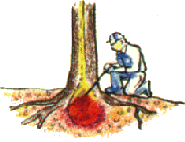
|
Subterranean white ants commonly build their nests at the base of a well established eucalyptus or other susceptible trees.
We recommend the test drilling of all susceptible trees, located within a 50m radius and within the property boundary. If white ants are located therein, a long thermometer is inserted into the tree trunk to determine if the central colony nest has been penetrated. |
 Intrigue white ant dust, discussed in detail below, or Premise liquid termiticide can be injected through the drill holes to eradicate any white ant nest located therein. A tree sealant is then inserted into the drill holes to ensure the tree remains healthy. Rest assured, these chemicals will not harm the tree. Intrigue white ant dust, discussed in detail below, or Premise liquid termiticide can be injected through the drill holes to eradicate any white ant nest located therein. A tree sealant is then inserted into the drill holes to ensure the tree remains healthy. Rest assured, these chemicals will not harm the tree.
 CONSUMER NOTE: With white ant nest location and colony elimination, there can be no guarantee of certain protection of nearby buildings, as there may be other unlocated hidden white ant nests near your property, for example, in trees on neighboring properties that cannot be accessed. There also maybe a white ant nest located under concrete slab flooring or within enclosed patios of your property or your neighbouring property. CONSUMER NOTE: With white ant nest location and colony elimination, there can be no guarantee of certain protection of nearby buildings, as there may be other unlocated hidden white ant nests near your property, for example, in trees on neighboring properties that cannot be accessed. There also maybe a white ant nest located under concrete slab flooring or within enclosed patios of your property or your neighbouring property.
| White Ant Colony Baiting & Elimination Systems |

 |
White Ant Colony
Elimination System |
 The Eco-Safe White Ant Colony Elimination System uses specially configured white ant monitoring stations to accumulate large numbers of white ants that can then be treated with Intrigue white ant dust. Although deadly to white ants, it is slow acting (several weeks) and is therefore spread to other white ants in the colony by their mutual feeding and grooming. Bait ingestion by sufficient white ants will lead to the eventual elimination of the entire colony. The Eco-Safe White Ant Colony Elimination System uses specially configured white ant monitoring stations to accumulate large numbers of white ants that can then be treated with Intrigue white ant dust. Although deadly to white ants, it is slow acting (several weeks) and is therefore spread to other white ants in the colony by their mutual feeding and grooming. Bait ingestion by sufficient white ants will lead to the eventual elimination of the entire colony.
 Intrigue white ant dust is manufactured by Bayer as an Australian product tested against Australian white ants. Intrigue works to prevent the white ants from moulting and growing a new exoskeleton, essential for their survival. The queen and the destructive workers are the first to die and without them the colony is doomed. Intrigue white ant dust is manufactured by Bayer as an Australian product tested against Australian white ants. Intrigue works to prevent the white ants from moulting and growing a new exoskeleton, essential for their survival. The queen and the destructive workers are the first to die and without them the colony is doomed.
The Eco-Safe White Ant Colony Elimination System involves:
 Regular inspections of the property, buildings and accessible timbers, therein. Regular inspections of the property, buildings and accessible timbers, therein.
 Application of Intrigue white ant dust to white ant galleries and any live white ants found at each inspection, at intervals as recommended. White ants return to the nest and pass the dust to other white ants through mutual grooming and feeding. The larger the number of white ants that are dusted, the quicker and more certain is the white ant colony elimination process. It is usual to reinspect the area in about four weeks, to observe the result and reapply the Intrigue dust, if neccessary. Application of Intrigue white ant dust to white ant galleries and any live white ants found at each inspection, at intervals as recommended. White ants return to the nest and pass the dust to other white ants through mutual grooming and feeding. The larger the number of white ants that are dusted, the quicker and more certain is the white ant colony elimination process. It is usual to reinspect the area in about four weeks, to observe the result and reapply the Intrigue dust, if neccessary.
 Drilling susceptible trees, and the application of Intrigue white ant dust to any white ant nest or live white ants located therein. Drilling susceptible trees, and the application of Intrigue white ant dust to any white ant nest or live white ants located therein.
 Follow-up application of a chemical soil barrier to Australian Standard 3660 using Premise soil treatment chemical at the base of a building or other structures. Follow-up application of a chemical soil barrier to Australian Standard 3660 using Premise soil treatment chemical at the base of a building or other structures.
 Installation of EcoSafe white ant stations to monitor future white ant activity. Any live white ants subsequently found in the stations are dusted with the Intrigue white ant dust. Installation of EcoSafe white ant stations to monitor future white ant activity. Any live white ants subsequently found in the stations are dusted with the Intrigue white ant dust.
 The EcoSafe white ant stations contain an attractive timber food source for foraging white ants, and are positioned in areas judged by the white ant specialist to be an area conducive to white ant activity. This requires expert skill and judgement, based upon years of field-work experience in white ant control. The EcoSafe white ant stations contain an attractive timber food source for foraging white ants, and are positioned in areas judged by the white ant specialist to be an area conducive to white ant activity. This requires expert skill and judgement, based upon years of field-work experience in white ant control.
 The installation and monitoring of the EcoSafe white ant stations is essential to guard against other white ant nests within the area that may pose a serious threat to the building or other timber structures. The installation and monitoring of the EcoSafe white ant stations is essential to guard against other white ant nests within the area that may pose a serious threat to the building or other timber structures.
| A Comparative Analysis of the Alternative White Ant Baits |

 There are several alternative white ant colony elimination products available in the market-place, including (1) application of Arsenic dust to live white ants (2) the use of Intrigue dust in bait stations, such as the EcoSafe bait stations (3) the Sentricon white ant bait in their bait stations (4) and a new system using Exterra white ant bait in their bait stations. There are several alternative white ant colony elimination products available in the market-place, including (1) application of Arsenic dust to live white ants (2) the use of Intrigue dust in bait stations, such as the EcoSafe bait stations (3) the Sentricon white ant bait in their bait stations (4) and a new system using Exterra white ant bait in their bait stations.
We recommend the use of the Intrigue or the Exterra products due to the following circumstances.
 Intrigue and Exterra white ant baits non-repellant to the white ants and is of very low toxicity to humans. Intrigue white ant dust is exempt from the "POISON" labeling requirements of the pesticide regulations and is classified as a schedule 5 pesticide with a CAUTION notation only on the pesticide label. Intrigue and Exterra white ant baits non-repellant to the white ants and is of very low toxicity to humans. Intrigue white ant dust is exempt from the "POISON" labeling requirements of the pesticide regulations and is classified as a schedule 5 pesticide with a CAUTION notation only on the pesticide label.
 Arsenic dust is a highly toxic compound that white ants can detect and therefore avoid; arsenic is a stomach poison able to quickly kill white ants on contact. As the white ants can detect where the arsenic dust is coming from they can easily seal off that area from the white ant colony nest, giving the property owner a false sense of security. The white ants can enter the building through other locations. Arsenic dust is a highly toxic compound that white ants can detect and therefore avoid; arsenic is a stomach poison able to quickly kill white ants on contact. As the white ants can detect where the arsenic dust is coming from they can easily seal off that area from the white ant colony nest, giving the property owner a false sense of security. The white ants can enter the building through other locations.
 Intrigue and Exterra are insect growth regulators which are slow acting on the white ant (several weeks) during which time the white ants readily transfer the Intrigue or Exterra white ant bait back to the other white ants in the colony. The affected queen white ant stops producing viable eggs and is assassinated by the workers. As these products are spread to other white ants in the colony during their feeding and grooming process....the eventual elimination of the white ant colony is expected in most cases where a large amount of white ants are feeding on the bait. Intrigue and Exterra are insect growth regulators which are slow acting on the white ant (several weeks) during which time the white ants readily transfer the Intrigue or Exterra white ant bait back to the other white ants in the colony. The affected queen white ant stops producing viable eggs and is assassinated by the workers. As these products are spread to other white ants in the colony during their feeding and grooming process....the eventual elimination of the white ant colony is expected in most cases where a large amount of white ants are feeding on the bait.
 Intrigue white ant dust can be applied directly to live white ants in their mud tube galleries or infested timbers, whereas the Sentricon baits are placed in their in-ground bait stations after removal of the white ant infested timber therein. This can involve major disruption of the white ants which can cause them to avoid the in-ground Sentricon bait station, entirely. This serious short-coming is overcome by the patented Exterra White Ant Stations where the timber is aligned around the cylinder such that the bait can be inserted without such disturbance of the white ants present. For detailed information on Exterra White Ant Colony Elimination System ... Click Here Intrigue white ant dust can be applied directly to live white ants in their mud tube galleries or infested timbers, whereas the Sentricon baits are placed in their in-ground bait stations after removal of the white ant infested timber therein. This can involve major disruption of the white ants which can cause them to avoid the in-ground Sentricon bait station, entirely. This serious short-coming is overcome by the patented Exterra White Ant Stations where the timber is aligned around the cylinder such that the bait can be inserted without such disturbance of the white ants present. For detailed information on Exterra White Ant Colony Elimination System ... Click Here
 With the application of the Intrigue white ant dust there is no time delay from the time of the initial application to the worker white ants taking the Intrigue white ant dust back to the white ant colony. This means, in terms of treatment application time, the Intrigue white ant dust has a faster effect on the white ant colony. With the application of the Intrigue white ant dust there is no time delay from the time of the initial application to the worker white ants taking the Intrigue white ant dust back to the white ant colony. This means, in terms of treatment application time, the Intrigue white ant dust has a faster effect on the white ant colony.
 Another significant difference, is that Intrigue white ant dust is 80% active anti white ant chemical, whereas only 0.5% of Sentricon bait is active anti white ant chemical, due to repellency problems with the Sentricon bait at significantly higher dosage rates. Another significant difference, is that Intrigue white ant dust is 80% active anti white ant chemical, whereas only 0.5% of Sentricon bait is active anti white ant chemical, due to repellency problems with the Sentricon bait at significantly higher dosage rates.
Consumer Protection Advice: Be wary of any advertising or promise that a timber replacement warranty applies as regards subsequent white ant damage to a building using a white ant colony elimination system.
For example, some pest control companies promote a $100,000 Timber Replacement Warranty as regards the use of the Sentricon White Ant Colony Elimination System - BUT BE CAREFUL to read any proposed Service Contract carefully! Does this contract then specify that any such warranty may (or may not) apply at some future point in time as then determined by the company?
As with all white ant colony elimination systems there can be no absolute guarantee of protection of nearby buildings. There may be other white ant nests nearby the building that do not find the bait stations. Your home is a much bigger bait station. Other white ant nests may exist in trees, under concrete on-ground flooring and in-fill patios of your home or neighbouring properties.
|
 Intrigue and the Exterra products are highly recommended as part of a white ant colony elimination program where a complete chemical soil treatment is not practicable or desired and where a sufficiently large number of live white ants feed on the bait. Intrigue and the Exterra products are highly recommended as part of a white ant colony elimination program where a complete chemical soil treatment is not practicable or desired and where a sufficiently large number of live white ants feed on the bait.
 The Australian white ant control industry has used Premise as soil treatment chemical for more than five years and Intrigue white ant dust, for several years, with excellent results reported in the vast majority of circumstances. The Australian white ant control industry has used Premise as soil treatment chemical for more than five years and Intrigue white ant dust, for several years, with excellent results reported in the vast majority of circumstances.
 Intrigue white ant dust is an Australian product designed for use against Australian white ants. Sentricon was developed for use against American white ants, a different species that are not as disturbance wary as the destructive Australian white ant species. Intrigue white ant dust is an Australian product designed for use against Australian white ants. Sentricon was developed for use against American white ants, a different species that are not as disturbance wary as the destructive Australian white ant species.
| Application of Borate Chemical Treatment to Accessible Timbers |

 The direct application of Boracol, a borate chemical formulation to accessible timbers can prevent white ant attack to the treated timbers. Boracol is non-toxic to humans (mammals) and is designed upon contact to penetrate inside most building timbers. Life expectancy can be in excess of 20 years. Boracol also prevents fungal wood decay, borer attack and has some fire retardant properties. The direct application of Boracol, a borate chemical formulation to accessible timbers can prevent white ant attack to the treated timbers. Boracol is non-toxic to humans (mammals) and is designed upon contact to penetrate inside most building timbers. Life expectancy can be in excess of 20 years. Boracol also prevents fungal wood decay, borer attack and has some fire retardant properties.
 This application of Boracol is highly recommended (1) to timbers during construction, and (2) to existing buildings in situations where a complete chemical barrier cannot be installed, such as, the sub-floor and void timbers of attached terraces or duplexes. In addition, the product is ideally suited to environmentally sensitive locations. This application of Boracol is highly recommended (1) to timbers during construction, and (2) to existing buildings in situations where a complete chemical barrier cannot be installed, such as, the sub-floor and void timbers of attached terraces or duplexes. In addition, the product is ideally suited to environmentally sensitive locations.
| Non-Chemical Recommendations |

 Rapid white ant colony development and building infestation is usually associated with a readily available food and moisture source near by the central nest. Buildings are often constructed in a way that encourages white ant infestation and colony development, and allows white ants to gain undetectable entry from the soil to the structural timbers of the building. Rapid white ant colony development and building infestation is usually associated with a readily available food and moisture source near by the central nest. Buildings are often constructed in a way that encourages white ant infestation and colony development, and allows white ants to gain undetectable entry from the soil to the structural timbers of the building.
Therefore, it is essential for the home owner to carry out the following "non-chemical" recommendations.
 Moisture reduction underneath suspended floors and around the base of the building. This may include improving cross flow ventilation to the sub-floor, fixing any leaks from bathroom, kitchen, down pipes, guttering, air conditioning unit overflow etc, installation of age-drains in the sub-floor and at the base of the building. Moisture reduction underneath suspended floors and around the base of the building. This may include improving cross flow ventilation to the sub-floor, fixing any leaks from bathroom, kitchen, down pipes, guttering, air conditioning unit overflow etc, installation of age-drains in the sub-floor and at the base of the building.
 Removal of any timber in contact with the soil. Timbers should be stored above the ground so you can inspect underneath. Removal of any timber in contact with the soil. Timbers should be stored above the ground so you can inspect underneath.
 Inspection access - Make sure with concrete slab on ground flooring that you can inspect the entire external slab edge for evidence of white ant mud-shelter tubes; also ensure where ever practicable that unimpeded inspection of sub-floor (suspended floors) can be undertaken to look for evidence of white ant activity. Inspection access - Make sure with concrete slab on ground flooring that you can inspect the entire external slab edge for evidence of white ant mud-shelter tubes; also ensure where ever practicable that unimpeded inspection of sub-floor (suspended floors) can be undertaken to look for evidence of white ant activity.
 PLEASE NOTE: If you find live white ants or white ant affected workings DO NOT disturb the area as the white ant controller can introduce Intrigue or Exterra white ant bait to the live white ants present in an attempt to eliminate the white ant colony. If disturbed the white ants are likely to move elsewhere, and not be rediscovered until further obvious damage has been done. PLEASE NOTE: If you find live white ants or white ant affected workings DO NOT disturb the area as the white ant controller can introduce Intrigue or Exterra white ant bait to the live white ants present in an attempt to eliminate the white ant colony. If disturbed the white ants are likely to move elsewhere, and not be rediscovered until further obvious damage has been done.
| Regular Professional Inspections are essential ! |

 |
Australian Standard 3660 states "the installation of a chemical soil barrier does not negate the need for regular competent inspections - at intervals of 3 to 6 months where the white ant risk is high".
We usually recommend 3 monthly inspections be carried for the first 12 months following a chemical soil treatment. |
 A professional white ant inspection and report could save you thousands of dollars - specific areas inspected include accessible timbers within the sub-floor, roof void, exterior and interior of the building, other timber structures, fences and trees within a 50 metre radius of the buildings but within the property boundary. A professional white ant inspection and report could save you thousands of dollars - specific areas inspected include accessible timbers within the sub-floor, roof void, exterior and interior of the building, other timber structures, fences and trees within a 50 metre radius of the buildings but within the property boundary.
| Home Builders - White Ant Control Products |

|
